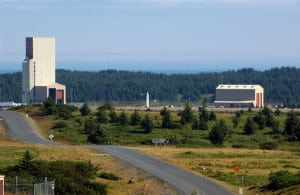Latest News
[Via Satellite 12-31-2014] Tumbling oil prices have led Alaska’s new Governor Bill Walker to implement a fiscal restraint order directing all state agencies to “halt to the maximum extent possible” discretionary expenditures for six projects, one of which is the Kodiak Launch Complex (KLC). Alaska Aerospace Corporation (AAC), an organization created by the State of Alaska in 1991, owns KLC and recently selected Lockheed Martin to conduct small and medium lift missions with Athena rockets. KLC is being upgraded to support a variant of the rocket called the Athena 2S, capable of lifting payloads weighing 1,900 to 3,000 kilograms to Sun-Synchronous Orbit (SSO).
The administrative order, issued Dec. 26, calls for the immediate cessation of all discretionary spending on the project and requires AAC not to incur new or additional expenses or obligations. AAC has also been directed not to spend any unobligated or encumbered funds that have been appropriated to the agency by the Alaska legislature, funds received from the federal government, or funds from other sources that have not been obligated or encumbered.
Furthermore, the order calls for AAC, and the other agencies involved in various state projects, to submit a report detailing discretionary funding obligations subject to the administrative order, nondiscretionary funding obligations, budgeted personnel costs for the remainder of fiscal year 2015 and operating costs status to date. The report must be sent to the director of the Office of Management and Budget by Jan. 5, 2015.
Mark Greby, SVP and COO of AAC told Via Satellite that the spending freeze only affects upgrades. Existing contracts are still proceeding. However, Greby was surprised to find that KLC has been looped in with larger ventures, such as the Susitna-Watana Dam and the Ambler Road Projects.
“I’m not quite sure how we got bundled in with megaprojects in the order of $5.7 billion,” said Greby. “We’re just a couple million [dollars], about the same as a mile or two of highway in cost.”
Greby added that AAC is meeting with the Office of Management and Budget on Friday, Jan. 2, 2015 and will have the governor’s reports submitted the following Monday.
Lockheed Martin is working with AAC to define the upgrades to KLC in order to launch a wider range of government and commercial payloads using Athena from Alaska. The two began a planning phase earlier this month. Once plans are completed, Lockheed Martin expects to receive a contract award from AAC.
Unlike other U.S. launch sites, KLC is not collocated on a federal range. As a high-latitude, full-service spaceport with wide southern launch azimuths over the North Pacific Ocean, the facility is favorable for launching satellites into polar, sun-synchronous and highly elliptical orbits. The Athena rocket can launch from other facilities, such as Cape Canaveral Air Force Station in Florida, where it has flown twice, but Lockheed Martin sees great value in launching from Alaska.
“It’s not as congested, Robert Cleave, president of Lockheed Martin Commercial Launch Services told Via Satellite in June. “There are a lot of launches going on at Cape Canaveral. At Vandenberg there are fewer, but there are still other users at Vandenberg Air Force Base for the range and the range support system. Anytime a user is using the range that means other users have to stand down and wait their turn in line. We don’t have that issue up in Alaska. We essentially have a much more straightforward regulatory environment to navigate.”
Cleave said Lockheed Martin is confident in having a very high probability of launching when they say they will because of fewer reasons for delays. While weather could certainly hold back a launch, having KLC as an option means the company can more readily execute missions.
“Business plans and business models always have a date of when revenue will start, and every day that you miss that date means that more capital needs to be spent on the company because you’ve got operating expenses with your staff and your people, or you miss your market or others may take your market away from you,” Cleave continued. “Having that schedule certain, which is true for both Atlas and Athena, we think of as part of the overall value proposition, and we recognize some clients will value that.”
Lockheed Martin has flown the Athena rocket seven times with two launch anomalies. The Athena 1c, capable of delivering around 300 kilograms to SSO, has launched four times, and the Athena 2c, capable of approximately 1,000 kilograms to SSO, has flown three times. In June, Cleave said Lockheed Martin envisions a market capable of supporting as many as 12 Athena launch opportunities a year.
Get the latest Via Satellite news!
Subscribe Now